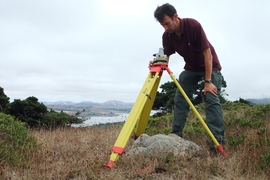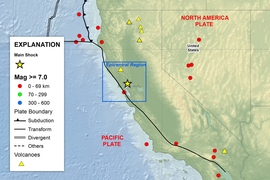Nearly two years ago, on August 24, 2014, just south of Napa, California, a fault in the Earth suddenly slipped, violently shifting and splitting huge blocks of solid rock, 6 miles below the surface. The underground upheaval generated severe shaking at the surface, lasting 10 to 20 seconds. When the shaking subsided, the magnitude 6.0 earthquake — the largest in the San Francisco Bay Area since 1989 — left in its wake crumpled building facades, ruptured water mains, and fractured roadways.
But the earthquake wasn’t quite done. In a new report, scientists from MIT and elsewhere detail how, even after the earthquake’s main tremors and aftershocks died down, earth beneath the surface was still actively shifting and creeping — albeit much more slowly — for at least four weeks after the main event. This postquake activity, which is known to geologists as “afterslip,” caused certain sections of the main fault to shift by as much as 40 centimeters in the month following the main earthquake.
This seismic creep, the scientists say, may have posed additional infrastructure hazards to the region and changed the seismic picture of surrounding faults, easing stress along some faults while increasing pressure along others.
The scientists, led by Michael Floyd, a research scientist in MIT’s Department of Earth, Atmospheric and Planetary Sciences, found that sections of the main West Napa Fault continued to slip after the primary earthquake, depending on the lithology, or rock type, surrounding the fault. The fault tended to only shift during the main earthquake in places where it ran through solid rock, such as mountains and hills; in places with looser sediments, like mud and sand, the fault continued to slowly creep, for at least four weeks, at a rate of a few centimeters per day.
“We found that after the earthquake, there was a lot of slip that happened at the surface,” Floyd says. “One of the most fascinating things about this phenomenon is it shows you how much hazard remains after the shaking has stopped. If you have infrastructure running across these faults — water pipelines, gas lines, roads, underground electric cables — and if there’s this significant afterslip, those kinds of things could be damaged even after the shaking has stopped.”
Floyd and his colleagues, including researchers from the University of California at Riverside, the U.S. Geological Survey, the University of Leeds, Durham University, Oxford University, and elsewhere, have published their results in the journal Geophysical Research Letters.
Right time, right place
Floyd and co-author Gareth Funning, of UC Riverside, have been studying fault motions in northern California for the past seven years. When the earthquake struck, at about 3:20 a.m. local time, they just happened to be stationed 75 miles north of the epicenter.
“At the time, I did stir, thinking, ‘C’mon, go back to sleep!’” Floyd says. “When we woke up, we turned on the news, figured out what happened, and immediately got back in our cars, picked up the instruments we had in the field, drove down the freeway to American Canyon, and started to put out instruments at sites we had measured just a few weeks before.”
Those instruments made up a network of about a dozen GPS receivers, which the team placed on either side of the fault line, as close to the earthquake’s epicenter as they could. They left most of the instruments out in the field, where they recorded data every 30 seconds, continuously, for three weeks, to observe the distance the ground moved.
“The key difference between this study and other studies of this earthquake is that we had the additional GPS data very close to the epicenter, whereas other groups have only been able to access data from sites farther away,” Floyd says. “We even had one point that was 750 meters from the surface rupture.”
Creeping faults, silent shadows
The team combined its GPS data with satellite measurements of the region to reconstruct the ground movements along the fault and near the epicenter in the weeks following the main earthquake. They found that the fault continued to slip — one side of the fault sliding past the other, like sandpaper across wood — at a steady rate of several centimeters per day, for at least four weeks.
“The widespread and rapid afterslip along the West Napa Fault posed an infrastructure hazard in its own right,” the authors write in the paper. “Repeated repairs of major roads crosscut by the rupture were required, and in some areas, water pipes that survived the [main earthquake] were subsequently broken by the afterslip.”
The earthquake and the afterslip took many scientists by surprise, as seismic data from the area showed no signs of movement along the fault prior to the main shock.
“I think we need to be more alert to the possibility that even faults without previously known surface fault creep may respond differently for reasons of material properties in the near surface geology,” says James Lienkaemper, a researcher with the United States Geological Survey at Menlo Park, California, who was not involved in the study. “We need to be aware that afterslip can occur in circumstances not previously expected.”
Regarding the afterslip’s possible effects on surrounding faults, the researchers found that it likely redistributed the stresses in the region, lessening the pressure on some faults. However, the researchers note that the afterslip may have put more stress on one particular region near the Rodgers Creek Fault, which runs through the city of Santa Rosa.
“Right now, we don’t think there’s any significantly heightened risk of quakes happening on other nearby faults, although the risk always exists,” Floyd says.
Curiously, the scientists identified a large region beneath the West Napa Fault, just northwest of Napa, which they’ve dubbed the “slip and aftershock shadow” — a zone that was strangely devoid of any motion during both the earthquake and afterslip. Floyd says this shadow may indicate a buildup in seismic pressure.
“The fact that nothing happened there is almost more cause for concern for us than where things actually happened,” Floyd says. “It would produce a fairly small quake if that area was to rupture, but there’s just no knowing if it would continue on to start something more.”
Floyd says that in developing seismic hazard assessments, it’s important to consider afterslip and slowly creeping faults, which occur often and over long periods of time following the more obvious earthquake.
“There are some earthquakes where we think we might be seeing some activity even 15 years after the main quake,” Floyd says. “So the more examples of an earthquake happening followed by afterslip that we can study, the better we can understand the entire process.”
This research was supported, in part, by NASA and the National Science Foundation.













